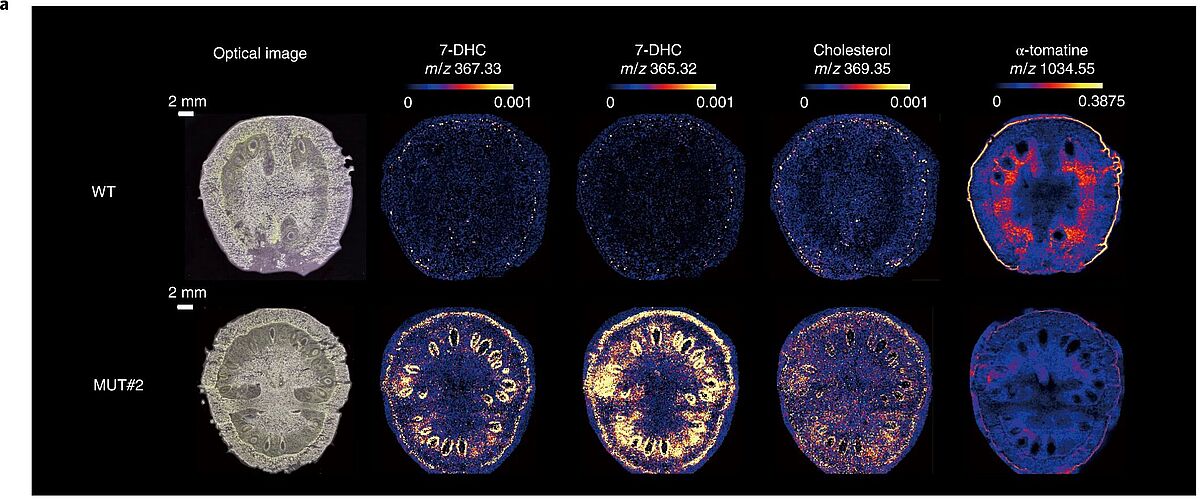Let's start simple: Seven fun facts about tomatoes
- Tomatoes originated from a wild plant in South America, possibly in the Peruvian Andes
- Today, China is the world’s largest tomato producer
- Tomatoes are not always red–they can be pink, orange, yellow, white, and even black
- The largest tomato plant in the world was grown at Walt Disney World in Florida–it measured nearly 57 square meters, or the size of an Olympic swimming pool
- Although your grocery store probably only has five or six varieties, there are about 10'000 known varieties globally
- Tomatoes have been grown in space
- Tomatoes are a good source of vitamin C, vitamin K, folate, and potassium
Tomatoes are tasty, nutritious, and easy to grow. But what they aren’t good for is giving you vitamin D, which is a key nutrient for human health. Now, that may be about to change, thanks to CRISPR gene editing technology.
Vitamin D: The elusive nutrient
Vitamin D is a critical nutrient for humans. It can help lower blood pressure, might reduce the risk of heart disease, can lower the risk of type 2 diabetes, helps you lose weight, puts you in a good mood, and might even prevent some kinds of cancer.
While it is possible to gain vitamin D through exposure to the sun and vitamin supplements, many want to get the nutrient through their diets. The best sources of vitamin D are from some fish and fish liver oils, plus you can get some in eggs and cheese. All of these sources are elusive for vegetarians and vegans, who make up one of the fastest-growing social movements in the world. Expect those numbers to grow in coming years: Vegan diets have been touted as having the smallest carbon footprint of any of the major diets and have been identified as a way to fight climate change.
Vitamin D insufficiency is common even among those who are not vegans. Vitamin D deficiency affects about 3 million people in the United States and an estimated 1 billion globally, with severe cases leading to bones that are thin, brittle, or misshapen, and pain or weakness in muscles.
Can CRISPR gene editing provide a solution to this problem? Perhaps.
Gene editing successfully adds vitamin D3 to tomatoes
According to a study published in Nature 2, an international team of researchers successfully engineered the accumulation of provitamin D3 in tomatoes.
The team used a Money Maker tomato plant and CRISPR technology to modify the gene structure and create a “biofortified food with the added possibility of supplement production from waste material.”
To convert the provitamin D3 into a vitamin D3 that humans can beneficially use, the tomatoes were treated with UVB light. After editing and treatment, the provitamin D3 in one tomato, once converted to vitamin D3, yielded about the same amount of vitamin D3 as what you would get from an ounce of tuna or two medium-sized eggs.
FIgure 1: Localization and quantitative comparison of 7-DHC, SGAs and cholesterol in wild-type and 7-DR2-knockout lines and conversion of 7-DHC in Sl7-DR2 knockouts to vitamin D3 by UVB irradiation.2
a) MALDI images of 7-DHC (m/z 367.33) and its laser-induced derivative ion (m/z 365.32), cholesterol (m/z 369.35) and α-tomatine (m/z 1,034.55). Scale bar, 2 mm. The HotMetal2 colour scale indicates the range of total ion current-normalized intensity. The same metabolite is shown with identical scale intensity for wild-type and mutant samples. It is not straightforward to compare the relative abundance of different metabolites using MALDI images due to potentially different ionization efficiencies.
CRISPR-edited foods: Technology aims to create better tasting foods that are more nutritious and easier on the planet
CRISPR tomatoes are just the latest entrant in a growing field of CRISPR-edited foods.
In the Northwest U.S., for example, experiments are ongoing to CRISPR-edit hops in order to create a beer-making ingredient that has a lower environmental impact. CRISPR is also being used to replicate the flavor and aroma of beer without hops at all – the substitute is a strain of brewer’s yeast created using CRISPR.
CRISPR technology is also being used to create more male cows since they gain weight more efficiently than females, edit pig sperm so their offspring are female (which would do away with the need to castrate male pigs), and determine the sex of a chick before it hatches.
Get set for more CRISPR-edited foods, experts say. Global food needs continue to increase, consumers are demanding healthier food alternatives, and climate change is stressing once-dependable crops—all of which suggests that in the future you will likely see more CRISPR-edited foods on your local grocery store shelf, and maybe even a dose of vitamin D in tomatoes.
References
- https://inhabitat.com/mickey-mouse-sustainable-farming-at-disney-worlds-epcot-center/
- Li, J., Scarano, A., Gonzalez, N.M. et al. Biofortified tomatoes provide a new route to vitamin D sufficiency. Nat. Plants 8, 611–616 (2022). https://doi.org/10.1038/s41477-022-01154-6
Supplier for CRISPR products
Integrated DNA Technologies (IDT) is your advocate for the genomics age. They produce tools for NGS, CRISPR, qPCR and PCR. Their products include DNA/RNA oligos, genes and gene fragments. For more than 30 years, IDT's innovative tools and solutions for genomics applications have been driving advances that inspire scientists to dream big and achieve their next breakthroughs.



